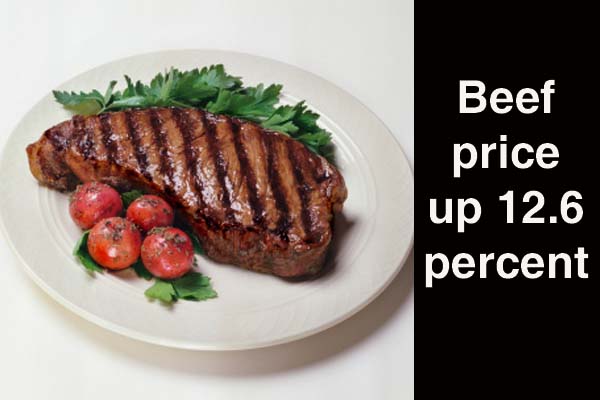Latest stats: youth and women continued to be unemployed at nearly twice the national rate
• Food prices continue to increase – beans up 18.3%
• Import bill triples domestic exports
The Statistical Institute of Belize (SIB) has released its most current national statistics, which indicate good news on the unemployment front for working males—but grim news for women and youth, who continue to suffer high rates of unemployment.
Cost of living pressures have eased somewhat, with a decline of the consumer price index; however, food prices and healthcare costs continue to be on the rise.
Meanwhile, Belize’s major domestic exports continue to face challenges, even as the import bill pushes towards the two-billion-dollar mark.
Unemployment rate falls
“Females between the ages of 18 and 23 years make up the majority of unemployed youth”
Whereas the SIB has reported a fall-off in the unemployment rate—from 16.1% in September 2012 to 14.2% in September 2013—indications are that too many young people and too many women continue to be unemployed.
The unemployment rate among females is 21.5% – more than double the unemployment rate of males and substantially higher than the national average.
The SIB said that “While their unemployment rate fell by about five percentage points, youth continued to be unemployed at nearly the twice the national rate.”
Of note is that females between the ages of 18 and 23 years made up the majority of unemployed youth, and women in Toledo had the highest rate of joblessness in the country, the SIB reports.
|
NATIONAL STATS |
2012 |
2013 |
|
April |
15.3 |
13.1 |
|
September |
16.1 |
14.2 |
September 16.1 14.2
The SIB reports that the most recent Labour Force Survey (conducted September 2013) has revealed that there are 1,510 more Belizeans in the labor force who are now employed: 128,134 of 149,355 workers; but with more youths graduating from school this year, the unemployment rate had increased over April 2013.
“The Cayo District had the highest unemployment rate, while the Orange Walk District recorded the lowest rate,” the SIB said.
Almost 58 percent of employed persons were working in the private sector, up from about 55 percent in 2012. Another 27 percent were self-employed and almost 12 percent were government employees.
The median monthly income for employed persons rose by 1.6 percent from $886 to $900.
According to the SIB, Belize’s population, as of September 2013, was 352,000, with an almost equal number of males and females. The population growth is reported at 2.6 percent over September 2012.
Inflation was 0.5% for 2013
“Red Kidney Beans up 18.3%”
“The Consumer Price Index (CPI) for the month of December 2013 was 103.6 (February 2011 = 100). This represents an increase of 1.6 percent over the 102.0 in December 2012,” said the SIB.
Food prices, which were the largest contributor to this increase, were up by almost 3 percent over the previous year’s prices, the SIB reports.
“During the year, there were increases in the prices of food, electricity, hospital accommodation fees and transportation,” it added.
It furthermore detailed that, “Prices for Food and Non-Alcoholic Beverages rose by 1.5 percent during 2013, with the most significant increases being in beef (!12.6 percent), poultry (!1.3 percent) and rice (!8.0 percent).”
Red kidney beans are up 18.3% from $1.76 to $2.08 a pound and eggs up by almost 12% on the dozen.
Furthermore, electricity tariffs rose from an average of 41.81 cents to 48.86 per kilowatt hour in January 2013—a total of 17%. (Of note, though, is that the rate was reduced by 8% in January 2014.)
According to the SIB, “…the increase in prices accelerated in the last five months of 2013, putting inflation for the year at 0.5 percent, down from 1.3 percent in 2012.”
The SIB notes that the inflation rate was “relatively low” because of lower clothing and footwear prices and health insurance and motor vehicle insurance premiums.
Meanwhile, an increase in the cost of hospital accommodation pushed the health index up by 3%.
“At the municipal level, Belmopan recorded the highest inflation rate for 2013 (!1.4 percent), followed by Corozal Town (!1 percent). The lowest was in Dangriga, where no change was recorded,” the SIB said.
Imports triple exports
“…lower earnings from crude petroleum, citrus concentrate and bananas”
According to the SIB, Belize’s import bill stood at $1.86 billion for 2013—triple the value of Belize’s domestic exports.
The import bill has notably expanded 8% since 2012, when Belize imported $1.72 billion worth of goods.
“The bulk of this increase is attributed to the country’s two largest foreign purchases, Machinery & Transport Equipment and Manufactured goods, whose imports rose by $51.1 million and $55.0 million dollars, respectively,” the SIB said.
Belize imported $597.3 million worth of goods from the United States – which has reclaimed the 32% share it held two years ago. Meanwhile, purchases of goods from Mexico and CARICOM were also at their highest level ever, but imports from Panama and China fell for a second consecutive year, due directly to a decrease in free zone purchases.
“In stark contrast to imports, the value of domestic exports declined by 7.5 percent to $627.6 million,” the SIB said. “This drop was primarily due to lower earnings from crude petroleum, citrus concentrate and bananas. Earnings from crude petroleum, in particular, fell by $46 million as a result of lower production. Sales of sugar remained at $107 million despite an 8 percent increase in volume.”
The SIB notes that due to the falloff in crude petroleum sales, the European Union (EU) marginally overtook the US as the largest consumer of goods from Belize. Together, the EU and the US take 80% of Belize’s exports. Exports to CARICOM are also healthy, having soared for a fourth straight year and reaching an all-time high of $86.7 million, the SIB said.
“Much of this increase was due to a $17 million surge in animal feed sales to Jamaica,” it explained.

